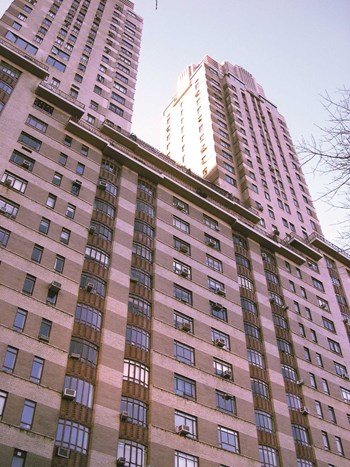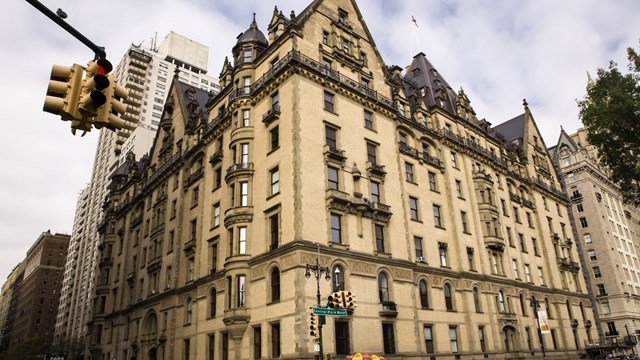
The idea of cooperative living was hatched in the early 1900s in New York City as a way for people to either have a say in who they had as neighbors, or as a way for building tenants to band together and exert some control over their quality of life. The grand, palatial residential buildings along Fifth Avenue, Park Avenue and Central Park West represent some serious architectural chops, but they also represent a lifestyle that is in many ways unique to New York City.
Palatial Pioneers
Towards the turn of the 20th century, buildings started going up in the largely undeveloped areas of Manhattan along the recently completed Central Park. What made them different from other development in the city was the concept: town home living in a multifamily structure. In order to lure wealthy buyers both uptown and out of the horizontal format of private homes, these buildings were luxuriously appointed and attempted to retain the air of privacy that private homes afforded.
"On the West Side, the San Remo, the Beresford and the Dakota have the most architectural significance," says Glenn Norrgard of Sotheby's International. With their towers and gables, these buildings create an iconic skyline on the western face of Central Park.
"People hadn't really lived in this type of community before," says Julianne Bond, a broker with the Maytays Group, a division of Corcoran Group Real Estate that deals with luxury properties all over Manhattan. "Many of them started out as co-ops, but some of them started out as luxurious rentals."
"The 1920s is the era that represented the heyday for these types of places," says Sherry Maytays, Maytays Group senior vice president. "On Central Park West, a slightly older breed is The Kenilworth, and the Dakota."
Emery Roth, the architect for several of these grandly styled residences, developed measurements for standard room sizes and proportions based on comfort levels of space within each room and home. In addition, most of these buildings have more than one entrance, allowing for additional privacy when entering and leaving the building.
"They were trying to lure people out of townhouses," continues Maytays. "The structures were created so that the lower floors are very decorated, the centers of the building are a little on the boring side, and then the upper floors are quite ornate."
More than just the physical structure, these buildings offered residents something else that was new: the ability to have a say in who co-occupied the building with them. "Beginning in the 1920s they had the mindset of a social club—an opportunity to discriminate socially and financially," says Louise Phillips Forbes, executive vice president of Halstead Property.
The Appeal
"One of the things that makes these buildings so appealing is the scale on which they are built," says Bond. "The ceiling heights, the details, the sound construction…there is some real substance and it feels very solid. These are grand-looking buildings with a great location. Right on the park, in good school districts—they offer so much to those who live there. They make very gracious homes, with fine and discrete service."
Another factor that makes these properties so desirable is their exclusivity, continues Bond. "The turnover rate is usually less, and that's part of what makes them so dear, in a way. There are typically more people looking for [these apartments] than we have apartments available, and unless someone needs to sell their unit, they tend to hang on to them."
With the real estate market flooding with brand-new luxury condominiums, one might think that the market for these older properties would be flagging, but that doesn't seem to be the case, says Bond. "For someone who doesn't necessarily care about location, the condo market might be siphoning off some buyers, but these co-ops are attractive for reasons that don't change, like location."
"I do not believe the co-op market has suffered because of the condo shift," says Forbes. "Some people don't want to go through the hoops, and some people really want to live in these older buildings. For some people, getting into these buildings is a sense of arriving."
Getting In
Getting into one of these "classic co-op" buildings requires more than just making the requisite millions. Like most things in New York, there is a strong element of "who you know" at play here. "The application process has not changed very much," says Forbes. "There are unspoken financial requirements of liquid assets, and social letters of reference that will make the difference in whether people will pass the board or not. The board packages that we put together require a tremendous amount of financial disclosure and four letters of reference."
This world can be quite small when you consider the pool of owners in this echelon of society, where a word makes all the difference, continues Forbes. "Often these letters of reference are from only an acquaintance or family friend, and often they don't even really know each other. Whether they actually socialize or not is less important than giving the board an insight to who those people know or are..."
Even when the requirements are met, there can be situations where buyers are rejected based on personal lifestyle or choices, like the oft-repeated tale of Whoopi Goldberg's many board applications and rejections on the Upper East Side. "There are buildings on Park Avenue that have turned down very wealthy buyers because they felt that their social consciousness was not what it should be," says Forbes.
Two things separate these types of applications from applications to other buildings in New York, says Norrgard. "One is that they want the apartment to be held in an individual name instead of in a trust, so that it is a primary residence, and two, the letters of recommendation, letters of reference."
In addition, "Sometimes a building will ask to escrow a year's worth of maintenance, to make sure that the payments will be made, but that's unusual," continues Norrgard.
Jumping through these hoops can be an ordeal, especially when the decision process is prolonged or intense. "The paperwork and the waiting game—I don't think the application process is fun for anyone," says Forbes, "but as the buildings attract certain individuals, the building's profile changes, and sometimes the requirements relax."
Sometimes, unusual rules for gaining residence can surface, and most are not published standards, but unspoken guidelines, continues Forbes. "In one building on Fifth Avenue, there is an unspoken rule that there are no children allowed. That isn't a published rule, but everyone in the industry understands that. In many cases, these buildings used to have a philosophy of not commingling old and new money. When Tommy Hilfiger was accepted into the Fifth Avenue building, it was a breakthrough of old and new money."
The Community
The lifestyle inside one of these white-glove, super luxury buildings holds a certain mystique for many on the outside, looking at the grand façade. Do the residents hang out with each other, or are they insular and private?
"One of the great things that New York has to offer is anonymity," says Maytays. "I think they intermingle as much as they wish. One new development in the last couple of years that brings people together is the health club. At a certain echelon in New York City, residents are more interested in having their private lives at home and having their public lives in other places."
Running Costs and Regulations
Once buyers are approved, the monthly costs of maintaining a residence of this type can be substantial, says Maytays. "There is a whole variety of ways that taxes and assessments are handled. Running costs can be very high."
"Most buildings' [maintenance fees] are about a couple of thousand dollars per month," adds Norrgard, "but they are paying a large staff. Some buildings can have a staff of 30 people to keep the building running."
"From $2.25 to three bucks per square-foot is not unusual [for maintenance,] says Forbes, "and carrying costs can be quite high because of the taxes."
The regulations of living in these buildings, which are often historic landmarks, might seem to carry some extra weight, but for the most part, rules here are much the same as rules in other buildings. "Often it is a no pets environment, but even that can be negotiable," says Forbes.
"Sometimes buildings will outlaw pianos and drums, or something to do with noise, but most are standard," says Norrgard.
Brokering the Deals
Working with these specialty apartments can present some challenges, says Forbes. "Since 9/11 I have seen a lot of quiet deals. Many never really get to the open market. There are a lot of people who are voyeurs and these quiet deals keep those eyes out. Many times, there may be a broker who can just put two people together."
"You need to do your homework and understand what is expected," adds Bond. "It's very important to be familiar with the board."
"In these kinds of transactions, having the experience with boards and understanding the subtleties of the dealings really makes a difference," continues Forbes. "I don't know a broker that doesn't aspire to having the opportunity to sell one of the Rockefeller's old estates, or a full floor on Fifth Avenue. We all enjoy and appreciate the architectural history and icons of New York."
Denton Tarver is a freelance writer, teacher and professional gardener living in New York City.





Comments
Leave a Comment